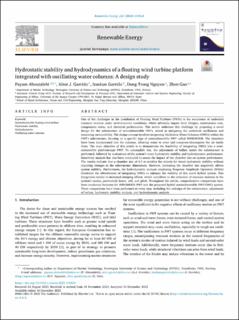| dc.description.abstract | One of the challenges in the installation of Floating Wind Turbines (FWTs) is the occurrence of undesired resonant motions under environmental conditions, which adversely impact their lifespan, maintenance cost, components stress, and electrical performance. This article addresses this challenge by proposing a novel design for the substructure of semisubmersible FWTs, aimed at mitigating the undesired oscillations and improving sustainability. The design concept involves integrating Oscillation Water Columns (OWCs) within the FWT’s substructure, focusing on a specific type of semisubmersible FWT called WINDMOOR. The chambers have been incorporated into the columns, allowing water to enter and compress/decompress the air inside them. The main objective of this article is to demonstrate the feasibility of integrating OWCs into a semi-submersible platform-type FWT. To accomplish this, the adjustment of ballast inside the substructure is performed, followed by evaluations of the system’s intact hydrostatic stability and hydrodynamic performance. Sensitivity analysis has also been conducted to assess the impact of the chamber size on system performance. The results indicate that a chamber size of 4.5 m satisfies the criteria for intact hydrostatic stability without requiring changes to the substructure dimensions. However, increasing the chamber size negatively affects system stability. Furthermore, the hydrodynamic analysis employing Response Amplitude Operators (RAOs) illustrates the effectiveness of integrating OWCs to enhance the stability of this novel hybrid system. This integration results in increased damping effects, which contribute to the reduction of resonant motions in the system’s modes, particularly heave, roll, and pitch. Throughout the article, comprehensive comparisons have been conducted between the WINDMOOR FWT and the proposed hybrid semisubmersible FWT-OWCs system. These comparisons have been performed at every step, including the redesign of the substructure, adjustment of ballast, hydrostatic stability analysis, and hydrodynamic analysis. | en_US |

